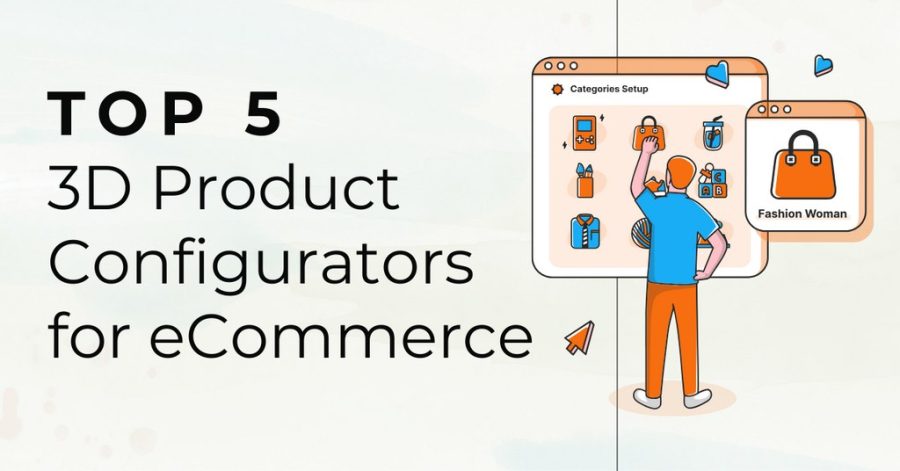
3D product configuration is the latest, and arguably greatest, evolution in the eCommerce shopping experience. Where users previously relied on a 2D image and product description to assess the qualities and suitability of a potential purchase, 3D product configuration invites a fully integrated review of the item in question – while allowing making adjustments according to unique needs.
Offering 3D product configuration can significantly bolster sales of consumer goods and complex, modular products, especially where customization is required. Utilizing this technology can also be labor-saving, as the responsibility for making adjustments remains in the hands of the consumer and drastically reduces the risk of product returns due to unsuitability.
How to choose the best 3D product configurator for your business
Many factors will play into your decision when considering a 3D product configurator. Some of the key considerations to take under advisement include:
- Complexity. Different eCommerce business websites will have varying needs on the complexity of 3D product configuration required. A unique T-shirt design, for example, will be considerably more straightforward to create than a bespoke cabinet or bicycle. Factor this complexity into your decision.
- Accuracy. The prime purpose of 3D product configuration is to ensure precise accuracy in measurements and real-time cost updates. Check that your provider can provide users with this exactitude to reduce the risk of product returns.
- User-friendliness. 3D product confirmation is a comparatively new technology and one that some users of an eCommerce business have not encountered before. Ensure any provider does not blind your customer base with science and leave them confused and overstimulated, leading to an abandoned cart.
- Compatibility. Most eCommerce sales, especially impulse buys, are made through smartphones and tablets. Ensure that your provider seamlessly integrates their service with iOS and Android technology while reviewing checkout options. While most 3D product configuration providers will support Shopify, not all are compatible with the equally popular Woocommerce platform.
- Pricing. The use of 3D product configurators will typically require an annual subscription. Ensure you are not eating into your profit margin by selecting an overpriced provider offering more features than you will need, especially if they also charge a commission fee on any sale made.
Top 5 best 3D product configurators for eCommerce
If you are keen to invest in the optimum 3D product configurator for your business, you will have an array of providers to choose from. As always, each vendor offers a unique series of pros and cons. This guide will help you understand which suppliers create optimum product configurations for eCommerce websites.
VividWorks
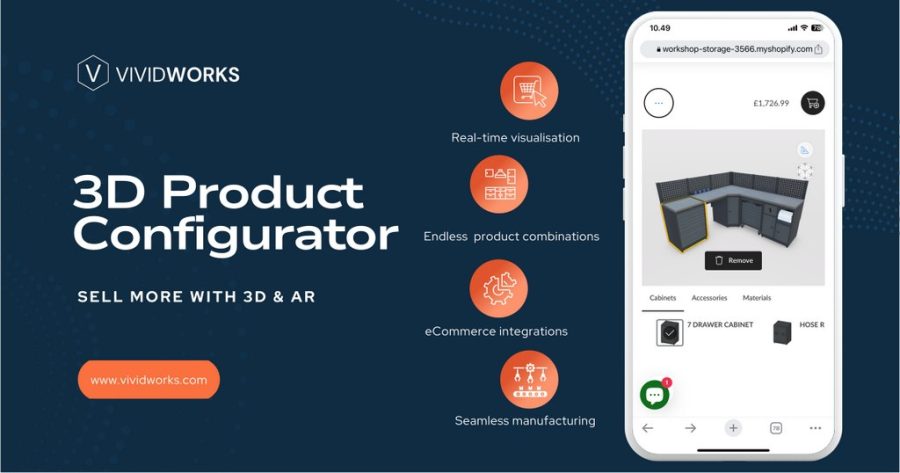
The award-winning configuration platform for complex products, VividWorks is arguably one of the finest choices for product configuration. While VividWorks offers the essential services you will find with most providers focusing on consumer goods, this provider can also suit a more elaborate business model, such as furniture, construction, or vehicle design. The 3D product configuration software VividWorks utilizes is rule-based, ensuring that it can cope with increasingly complex needs while retaining 100% accuracy in price quotations.
Users who wish to consider all possible variations on a product before committing to a purchase will see their needs met by VividWorks. This provider offers real-time price updates and precise measurements. This can be essential when designing a custom product with a wide range of possible combinations and variants of static, heavyweight items from scratch.
Integration with major platforms and apps
VividWorks can be used in conjunction with Shopify, WooCommerce, and Magneto, ensuring that your websites can build 3D configurators quickly and easily. Outside of eCommerce considerations, VividWorks’ 3D product configuration software can also be simply integrated with ERP, CRM, and other software. This ensures that a business’s manufacturing practices will become seamless and rapid, primarily thanks to a reduced need for back-and-forth during the design process. All files, including a bill of materials, assembly instructions, and stock-keeping units, will be automatically generated and uploaded to a manufacturer’s cloud.
Suitable for businesses of various industries, types, and sizes
The VividWorks platform is suitable for businesses of all sizes and types, ensuring anybody can easily install the plug-in to use and build your 3D Configurator. You will enjoy full support from the 3D expertise team, ensuring any products are tailored to your product catalog and store and that any 3D implementation meets the highest quality standards. The VividWorks customer showcase of product configuration also shows that they have built 3d product configurators for established brands and startups of different industries like Montana, EM Home, HAY, Lundia, and more.
AR-enabled Configurators
VividWorks’ 3D product configuration and AR-supplemented models are simple to view and interact with over any desktop computer or handheld appliance. Augmented Reality also ensures customers can create a virtual room and place products within, visualizing the space. There is no need to contact VividWorks to make changes – a business can instantly manage catalog, configuration and product amendments by itself.
Transparent Pricing
VividWorks is also wholly transparent in terms of their pricing for using product configuration. Pricing includes a one-time implementation charge and a subscription fee. The subscription will always be fixed as per a contract agreement, with no additional or hidden fees.
Threekit
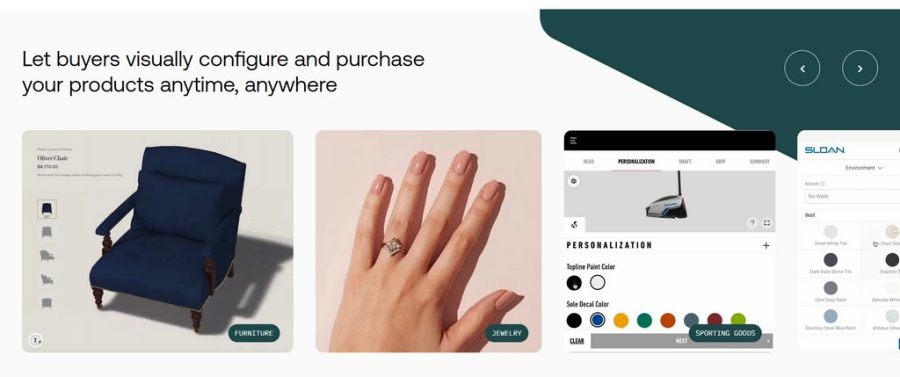
An eCommerce business that specializes in the sale of bespoke consumer goods will find plenty to love about Threekit. This product configuration provider has a long list of reputable clients, with a particular emphasis on the luxury market – Threekit includes the likes of Ralph Lauren and Louis Vuitton within its portfolio.
This makes Threekit a flexible provider of 3D product configuration, with an omnichannel approach opening the door to an array of services. Users can calculate adjustments to pricing in real-time using Threekit, and accuracy is ensured thanks to the precision of the technology. However, be aware that any changes in the configuration must be completed by Threekit, not the consumer. This can be inconvenient and lead to frustration at lost time and efficiency.
It should also be noted that these benefits can rapidly become costly. Threekit does not offer generalized pricing models – any expense to a business will be calculated according to bespoke needs, resulting in a custom price plan.
An eCommerce business interested in utilizing 3D product configuration through Threekit will be welcome to experiment with a demonstration on the company website, but no free trial is available after this. Only sign up for a Threekit contract if you are certain this provider will meet your product configuration needs, as there is no room for buyer’s remorse.
Zakeke
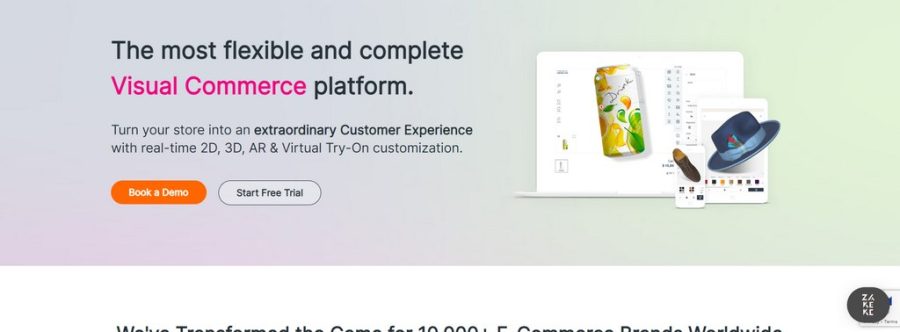
3D product confirmation technology can create an immersive shopping experience for eCommerce consumers that rivals offline browsing. Zakeke enjoys significant popularity in the consumer goods niche for this reason. Popular with clothing and jewelry designers and sellers, Zakeke provides online shoppers with a virtual fitting room, adding a welcome additional layer and customer confidence to a transaction.
On the other hand, some users have expressed frustration with the simplified options available through Zakeke. A small availability of varying sizes and colors has often been raised as a point of contention and suggests that Zakeke is arguably not fully harnessing the significant power of 3D product configuration.
This does not mean Zakeke should be ignored, especially by anybody seeking 3D product configuration for an eCommerce business. Unlike some competitors, Zakeke is not only compatible with Shopify when managing checkout – it is also a Woocommerce-friendly product configurator.
Just remain mindful of the limited options that will be made available to a customer base, and be sure to review your budget and bottom line carefully. According to Zakeke’s pricing page, transaction fees are applied in addition to a monthly subscription.
Zoovu
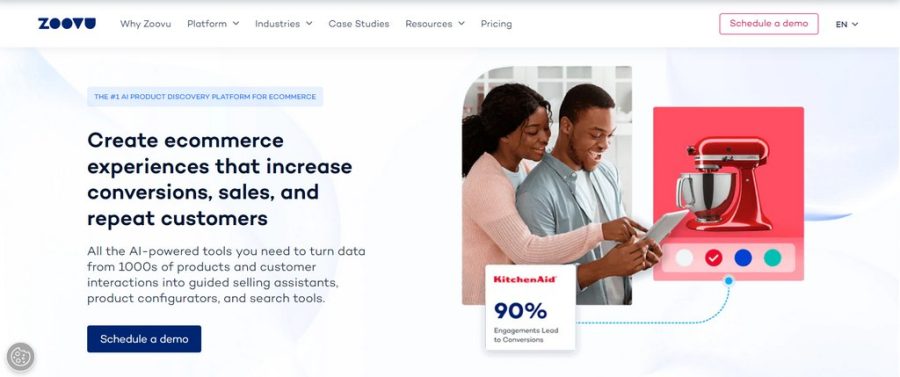
AI plays an increasingly prominent role in our online lives, and Zoovu has embraced this brave new world with gusto. Teaming with Belgian tech giant Clever, Zoovu has implemented conversational AI into its 3D product configuration, going some way to replicate the experience of discussing needs and amendments with a retail assistant.
Your mileage may vary as to how much emphasis you would like to place on this for your business. While AI can enhance sales and shopping experience by guiding a consumer through simple adjustments and gently edging buyers into a sales funnel, the technology still has limitations yet to be ironed out.
Consumer goods are one consideration, and will likely benefit from AI intervention as a cost- and labor-saving exercise. However, resolving queries and concerns surrounding complex, bespoke products may be beyond the wit of even the most immaculately coded AI model. Sometimes, involving chatbots causes more frustration to users than it resolves.
If you run a comparatively straightforward eCommerce business model, Zoovu’s approach can offer plenty of advantages. Just do not expect the technology to run before it has fully learned to walk. This business is also reluctant to discuss pricing, with no public costings listed, so think carefully about what you may or may not wish to include in an eventual subscription package before making contact.
Vectary
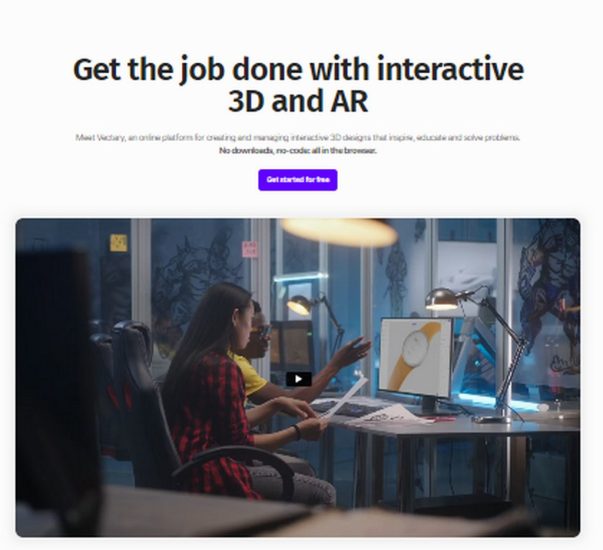
Vectary places significant pride and emphasis on simplicity in 3D product configuration. This provider offers 3D and augmented reality solutions that can be seamlessly integrated into any eCommerce business website, so even a tech novice should not struggle to take advantage of Vectary’s offering. There will be no need to battle with countless lines of code or puzzle out vexing error messages.
Of course, simplicity is also a double-edged sword. Like many providers listed, Vectary is most effective for an eCommerce business specializing in consumer goods. While this provider will allow users to adjust size, fabric, and color, anything more complex may become troublesome. This means that Vectary is potentially unsuitable for a business that works with modular needs.
However, this is reflected in Vectary’s price plans. A free trial is available, as is a gratis service tier for any business owner that wishes to master 3D product configuration and test its viability before committing to an annual subscription – though most businesses will need to upgrade to the Pro tier at worst, or more likely, seek out a custom quote tailored to unique needs.
Conclusion
Finding the ideal 3D product configuration tool is not a decision to rush, as you will need to assess your business’s needs and find a provider that matches the ideals of your customer base. These five providers are a recommended launchpad for any eCommerce business looking to automate their inbound sales process and take their online shopping experience to the next level.